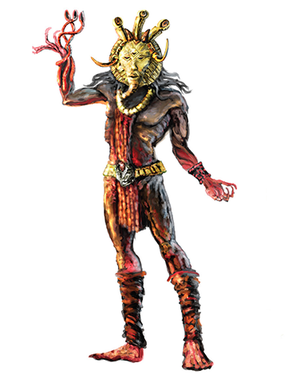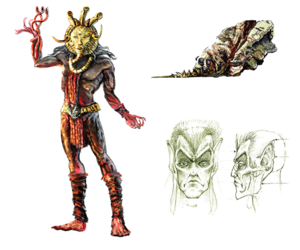Originally published April 29, 2022 by Parker Wilhelm. The original article can be found here.
THE ELDER SCROLLS III: MORROWIND 20TH ANNIVERSARY
Morrowind wasn't just a big deal for players – check out these tales from those who worked on the game 20 years ago.
MORROWIND TURNS 20!Edit
The Elder Scrolls III: Morrowind launched 20 years ago on May 1, 2002. Join us as we reminisce on this major milestone by sharing our experiences in Morrowind – both as developers and players.
On May 1, 2002, video game history was made when Bethesda Game Studios released The Elder Scrolls III: Morrowind. What turned out to be a major champion in the role-playing genre, and gateway for many console players, also doubled as a make-or-break moment for the studio. Morrowind was a pioneering venture, pushing technology and storytelling to create a memorable, breathing virtual world that players at the time had never experienced before – and one still worth revisiting, even today.
On May 1, 2022, we celebrate 20 years since Morrowind's launch and the path it paved for The Elder Scrolls series. Join some of those who worked on the game itself as they reminisce on working on the RPG classic and what made it such a special project to work on:
ESTABLISHING A FRANCHISEEdit
Bethesda Softworks was a much smaller company at the time, and Pete Hines recalls the many hats he needed to wear that would eventually lead him to his current role of SVP of Global Marketing & Communications. From requiring press to fax (yes, fax) signed NDA forms with photo ID to secure preview builds to taking lead on developing the strategy guide – a task that he jokingly remarks "nearly killed me" – it's both impressive and humbling to remember a time before The Elder Scrolls (an [sic] email, apparently) were established names. "Morrowind was a great game that did a lot of things well, had a great setting and sense of place, and kicked open the door to RPGs on console like nobody before or since," says Hines, "but I still think it was releasing the tools the devs used to make the game that put Morrowind on another level and really set the Elder Scrolls series on a whole new trajectory."
https://www.youtube.com/watch?v=MCYICHizwao
Though Morrowind stands on its own, the ability to mod and supplement the game really nailed the point home that player expression was key, leading to an audience of players that could not just embrace the game, but make it theirs. "It changed the way people thought about RPGs and opened them up to people who never considered playing them before," he says. "Oblivion ran through that door and Skyrim blew the door off its hinges, but Morrowind made it possible."
PUTTING MORROWIND ON THE MAPEdit
"It wasn't long after I was hired that I was tasked with drawing the printed map for Morrowind," says Michael Wagner, now Senior Marketing Art Director at Bethesda Softworks. "Now back then, we didn't have an automated way to see the whole game world at once, so I had to load up the TES Construction set and go section by section, drawing the map out with a Rapidograph pen onto paper."
"When I interviewed with Bethesda, (now-Senior Vice President of Development) Todd Vaughn showed me an early version of the game and I was amazed by it. It really made me super excited to work at the company. Really, Morrowind saved Bethesda and gave us the ability to make so many great games later on and to become the company we are today." "We released the Xbox version and not long after, found out that everyone at Xbox was talking about the game and people were just amazed by it. It was super exciting at the time because you just knew that Morrowind would be remembered as a classic and it would have a big impact on future games." Nowadays we're pleased to say that Wagner still produces art for Bethesda, though thankfully due to advancing technology, hasn't had to pull out the Rapidographs in a while. "Somehow it worked out," he says, "I will always remember that map art."
BREAKING INTO THE INDUSTRYEdit
"I was the QA Lead for the game for the outsource company that was being used at the time. We had a team of 10 people to test this gigantic game on two platforms," recalls Rob Gray, QA Director at Bethesda Softworks. "It was a welcome change from the family-oriented games that we were primarily doing at the time so we were all excited to work on it - both for the change and because we were all excited for the game itself." Often, testing a game requires pushing boundaries to find its limits and Morrowind was no exception. "In order to test the edge cases as best we could with such a limited team, we had to get creative," Gray says. "I had a tester who created an area-of-effect spell that was about as big as a town, but would only do one point of damage. He stood on a cliff overlooking Balmora and cast it on the entire town. I remember every NPC turning to look at the player and then chaos would happen - both in-game and in the real world. NPCs started attacking from wherever they could, and the hardware (whether console or PC) would start to go crazy."
Testing the boundaries was not only part of the job, but it also laid bare just how far those boundaries could go in Morrowind. "It was really the freedom the game gave me that made me love RPGs again. The landscapes are almost alien looking, the lore is super deep (but understandable) and the quests are so unique while still feeling familiar," Gray says. "From a career perspective, it's what ultimately got me in the door here. The QA Manager at the time hired me as one of the first batch of QA people in-house and I've been here ever since. I'm incredibly proud to say that I worked on it in some capacity and it will always be one of those keystone moments in my life I'll forever talk about."
FROM MODDER TO MAKEREdit
"Morrowind was my first game programming job," says Bethesda Games Studios Senior Programmer Mike Lipari. "I'd played Arena and Daggerfall and loved the massive worlds and flexibility of the Elder Scrolls games. I'd even written in asking if Daggerfall could have some sort of plugin system like 3DS MAX so users could flesh out the jail system to actually put the player in prison to let them escape." "Then a series of miracles occurred, and I end up a junior programmer working on Morrowind and helping develop The Elder Scrolls Construction Set to help make my (and every other modder's) dreams come true."
Of course, with such an ambitious project as Morrowind was at the time, there will still some growing pains – ones that have stuck with Bethesda Game Studios as growth for future projects. "In Morrowind, most forms did not have numeric IDs. Things like cells or areas in the exterior world just used their name, or editor ID, as their identifier," Lipari explains. "Then the game was translated, and character generation completely broke because for some reason the city of Seyda Neen (a totally made up name) had been translated into 'Sehda Nihn' for the French version of the game. There was much cursing and scrambling for fixes." Localization learnings aside – "Oblivion was suddenly slated for numeric IDs," Lipari adds – the focus on player expression and offering player not just the ability to live in, but change, their worlds proved to be a major hit with players.
"At level one you can get glass armor if you are willing to look for it and patient enough to steal it. You can Levitate over plot blocking barriers or jump them with Icarian Flight, (just make sure you save a scroll for landing). You are free to kill NPCs critical to the main quest as long as you are willing to sever the thread of prophecy and with a pile of home brewed ultra-powerful potions, you can defeat the main bad guy without all the items the main quest 'requires,'" Lipari recounts. "That kind of freedom is pretty rare in games and is probably worth a Cliff Racer battle or two (hundred)."
GIVING MORROWIND A VOICEEdit
"When I was first cast in Morrowind, I had only voiced animations and one game in which I basically played over 200 people dying in many painful, extravagant ways. A four-hour session of screaming and death gurgles couldn't have prepared me for the massive experience that Morrowind set before me," says Wes Johnson, voice actor for Boethiah, Malacath and Molag Bal in Morrowind and known in The Elder Scrolls community for his role as the Daedric Prince of Madness, Sheogorath
"The real impact of these sessions, which were directed by Todd Howard, came later once the game came out. Playing Morrowind was a revelation to me. Whereas doing voice for animations was fairly straightforward in regard to later viewing, this game world was such an immersive experience that I would dream that world after playing," Johnson says. "I gained a real respect for how intimate the interactions between NPCs and player characters could be. The world was alive in my mind and imagination, and I carried the full weight of my playing experience into the next Elder Scrolls project, Oblivion. When I lived the characters in Oblivion, I was deeply immersed in the 800 hours or more I had invested in Morrowind. The world lived and breathed for me, and I truly feel my work in video game voice acting benefited greatly from the experience."
On the topic of 'living' in Bethesda Game Studio's worlds, Johnson recalls how even a voice can become a part of the world's reality – even when it comes to everyone's individual interpretation of their character. "When recording the effort sounds, I asked how my Breton characters would react to being hit with a broadsword. I was told that they were mages, fairly effete and to respond accordingly," he recollects. "So my Bretons reacted as I think more people would when being bludgeoned and stabbed - they cried out in a high pitched squeal. I was later told by some players that they didn't appreciate that - Their mage would be rough, tough and take those slices and dices like a stoic stone warrior."
"Of course, that is where the real beauty of Morrowind and the Elder Scrolls lies - we don't have to be ourselves. We can be anything we want to be. In Morrowind's open world, we were able to live a life that felt real, heroic, adventurous and fun. The Elder Scrolls has the power to transport us to a different world. A world in which someone could very possibly steal your sweetroll if you're not careful!"
But that's not all! It's not just the people who made Morrowind who have a connection with its world. The players who took their first steps into Vvardenfell have their own stories to tell. Check out this article for even more tales of Morrowind, this time from fans who've gone on to work in video games themselves!
Tags: #THE ELDER SCROLLS ONLINE: MORROWIND #BETHESDA GAME STUDIOS #INTERVIEW

